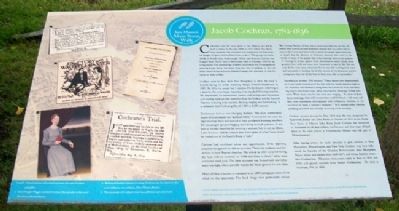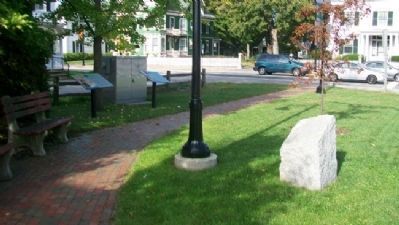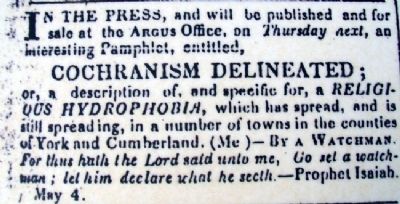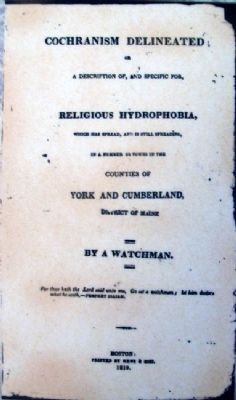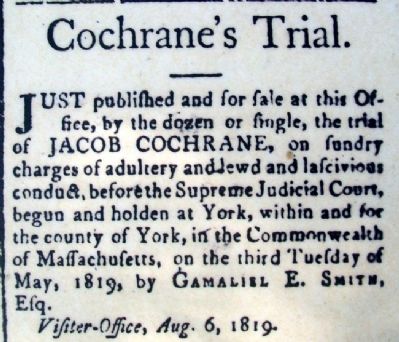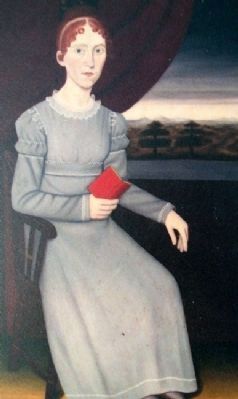Saco in York County, Maine — The American Northeast (New England)
Jacob Cochran, 1782-1836
Saco Main Street Museum Walk
Cochranism was the name given to the religious sect led by Jacob Cochran in the years 1816 to 1819, before this charismatic preacher was convicted and imprisoned for four years on charges of “gross lewd and lascivious conduct.” The group was active chiefly in North Saco, Scarborough, Hollis, and Buxton. Cochran was dragged from North Saco to downtown Saco in February 1819 for an arraignment. The proceedings probably occurred at the Congregational meeting house across the street from this site, or perhaps at the 342 Main Street home of Justice Daniel Granger who presided. A trial followed at York in May.
Cochran came to Saco from New Hampshire in 1816. He lived in Enfield during his youth, marrying Abigail Colcord Stephenson in 1805. By 1816, the couple had three children. He developed a following as a preacher, but soon began departing from standard Christian practice. He emphasized his supernatural powers, and incorporated hypnotism and worship exercises that borrowed from the Shakers and the Freewill Baptists, including holy marches, dancing, singing and footwashing. It is estimated that Cochran gathered 1,000 to 4,000 converts.
Cochranism had an ever-changing doctrine. The most controversial aspect of Cochranism was “spiritual wifery.” Cochran did not value the legal marriage bond and seemed to have prohibited it among members. He encouraged spouse swapping and having multiple partners. A witness at his trial describes his entering a woman’s bed to cure an illness. Later Cochran told the witness that if she spoke of it her “name would be blotted out of the Lamb’s Book of Life.”
Cochran had combined talent and opportunity. Even opposing preachers recognized his skills as an orator. There was weakness and dissention in local Baptist churches. His arrival in 1816 occurred during the “year with no summer,” or “1800 and froze to death,” when snow continued until June. The farm economy was bruised and unemployment was high, which partially explain the fertile ground for new ideas.
Much of what is known is contained in an 1895 newspaper series which relied on the opponents. The local clergy were particularly critical:
“Rev. George Parcher of Saco was so much exercised over the way the people were running to these diabolical excesses that it is said he left his team in a furrow and went forth to arouse his people against him, but so deeply had the doctrine of Cochran fastened their roots in the minds of many of the people that at his meetings held for the purpose of warning his people against these abominations many hissed, some gnashed their teeth and some even threatened to take his life. But
not only did he come away unharmed, but he was able to bring back many and succeeded in checking the further spread of this fanaticism and for a long time that was all the best of them were able to accomplish.”
According to another 1895 account, “These dances were characterized by a very quick movement of the feet, with the hands raised as high as the shoulders and allowed to hang down limp from the wrist, and keeping step to very lively music, when they had the advantage of that assistance. Their music was for the most part singing… At some of these dance meetings, their wild incantations could be heard a mile away and they were sometimes accompanied with voluptuous excesses, to the ruination of many a woman’s character…” It is unclear today whether anything untoward was actually occurring in the worship.
Cochran escaped during his May 1819 trial. He was recaptured by Rishworth Jordan and John Banks in October of 1819 at the North Saco home of follower John Berry. Jacob Cochran was sentenced in November to 18 days solitary confinement and four years of hard labor at the state prison in Charlestown. (Maine was still part of Massachusetts).
After leaving prison, he made attempts to gain converts in New Hampshire, Massachusetts and New York. Cochran may have influenced the founder of the Oneidan Perfectionists, John Humphrey Noyes, whose sect existed from 1849-1879, and whose doctrine resembles Cochranism. Mormon missionaries came to Saco in 1832 and 1833 and gained converts from former Cochranites. He died in Stratham, NH, in 1836.
[Photo captions read]
1. and 2. A local minister advertised and wrote this anti-Cochran pamplet.
3. Kate Douglas Wiggin included Cochran-like episodes in the novel The Story of Waitstill Baxter
4. Rishworth Jordan’s interest in seeing Cochran may be related to the sect’s influence on a relation, Mary Warren Bryant.
5. The transcript of Cochran’s trail was published and advertised.
Erected by City of Saco and Saco Museum.
Topics and series. This historical marker is listed in this topic list: Churches & Religion. In addition, it is included in the Communal and Utopian Societies series list. A significant historical month for this entry is February 1819.
Location. 43° 30.028′ N, 70° 26.578′ W. Marker is in Saco, Maine, in York County. Marker is at the intersection of Beach Street (Maine Route 9) and Main Street, on the right when traveling east on Beach Street. Touch for map. Marker is at or near this postal address: Joe Riley Park, Saco ME 04072, United States of America. Touch for directions.
Other nearby markers. At least 8 other markers are within walking distance of this marker. Samuel Brannan and the Gold Rush (here, next to this marker); Dr. Laura Black Stickney, 1879-1961 (within shouting distance of this marker); Veterans' Memorial at Eastman Park (within shouting distance of this marker); World War Memorial (within shouting distance of this marker); Veterans Memorial (within shouting distance of this marker); Spanish War and Philippine Insurrection Memorial (within shouting distance of this marker); War Memorial (within shouting distance of this marker); Sarah Fairfield Hamilton, 1831-1909 (within shouting distance of this marker). Touch for a list and map of all markers in Saco.
Credits. This page was last revised on May 30, 2021. It was originally submitted on May 27, 2012, by William Fischer, Jr. of Scranton, Pennsylvania. This page has been viewed 1,166 times since then and 62 times this year. Photos: 1, 2, 3, 4, 5, 6. submitted on May 27, 2012, by William Fischer, Jr. of Scranton, Pennsylvania.
